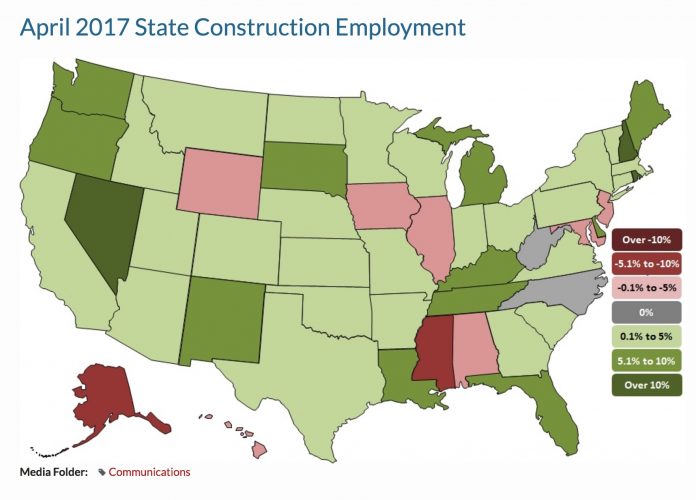Employment in California’s industry has thrived in the past year, increasing by 15 per cent (year to date in April) from 2016 to 803,600 employees from 772,800 the same month last year, an overall increase of 38,000 employees or 4.9 per cent. In absolute numbers, this was the highest job growth of all states in the past year.
Data from the federal Department of Labour compiled by the Associated General Contractors of America (AGCA) ranks the state as 15th in the nation in construction industry labor force growth. Notably, the improvement has continued even in month between March and April, when 7,200 new employees were added, increasing the labor force by 0.9%, ranking the state 12th in the nation.
Overall, 39 states added construction jobs between April 2016 and April 2017 amid growing demand for construction services, yet more than half the states lost construction jobs between March and April amid tight labor market conditions, according to an analysis by the AGCA of Labor Department data released in May. Association officials said firms in many parts of the country are having a hard time finding qualified workers, which is likely holding back broader employment gains in some states.

“Demand for construction remains robust, so it is likely that a number of the monthly employment declines are being caused by a lack of workers instead of a lack of work,” said Ken Simonson, chief economist for the association. “If the labor market remains tight, firms may have to adjust their business practices as they shift limited personnel from one project to the next.”
Besides California, other states adding a high number of new construction jobs for the past 12 months include Florida (34,400 jobs, 7.4 percent); Washington (11,200 jobs, 6.1 percent); Nevada (9,700 jobs, 13.0 percent) and Michigan (8,200 jobs, 5.3 percent). Nevada also added the highest percentage of new construction jobs during the past year, followed by New Hampshire (10.2 percent, 2,600 jobs); Rhode Island (10.0 percent, 1,800 jobs) and Oregon (9.0 percent, 8,000 jobs). Nebraska was the only state to set a new high for construction employment.
Nine states and the District of Columbia shed construction jobs between April 2016 and April 2017 while construction employment was unchanged in North Carolina and West Virginia. Illinois lost the highest number of construction jobs (-6,600 jobs, -3.0 percent), followed by Mississippi (-3,600 jobs, -8.1 percent) and Maryland (-1,400 jobs, -0.9 percent). Mississippi lost the highest percentage for the year followed by the District of Columbia (-7.5 percent, -1,200 jobs) and Alaska (-6.6 percent, -1,100 jobs).
Among the 27 states that shed construction jobs between March and April, Texas lost more than any other state (-10,300 jobs, -1.4 percent), followed by Ohio (-7,400 jobs, -3.4 percent) and Illinois (-4,500 jobs, -2.1 percent). Montana (-3.8 percent, -1,100 jobs) lost the highest percentage of construction jobs for the month, followed by Ohio; West Virginia (-2.8 percent, -900 jobs) and Kansas (-2.5 percent, -1,600 jobs).
Twenty-one states added construction jobs between March and April while construction employment was unchanged in two states and the District of Columbia. California (7,200 jobs, 0.9 percent) added the most construction jobs for the month. Other states adding a high number of construction jobs include Minnesota (3,600 jobs, 3.0 percent); Nevada (2,700 jobs, 3.3 percent) and Arizona (2,500 jobs, 1.8 percent). Connecticut (4.7 percent, 2,800 jobs) added the highest percentage of construction jobs during the past month, followed by New Hampshire (3.7 percent, 1,000 jobs); Nevada and Minnesota.
Association officials urged federal, state and local officials to take additional steps to make it easier for school systems to set up career and technical education programs focusing on construction. In particular, they urged Congress to work quickly to pass new Perkins Act legislation that will increase funding for career and technical education programs and give local school officials more flexibility to offer courses based on local workforce demands.
“Investing in career and technical education programs not only provide vital professional skills, they also signal to students that high-paying construction careers should be an option for the future,” Stephen E. Sandherr, chief executive officer for the association, said. View the state employment data by rank and state. View the state employment map.














